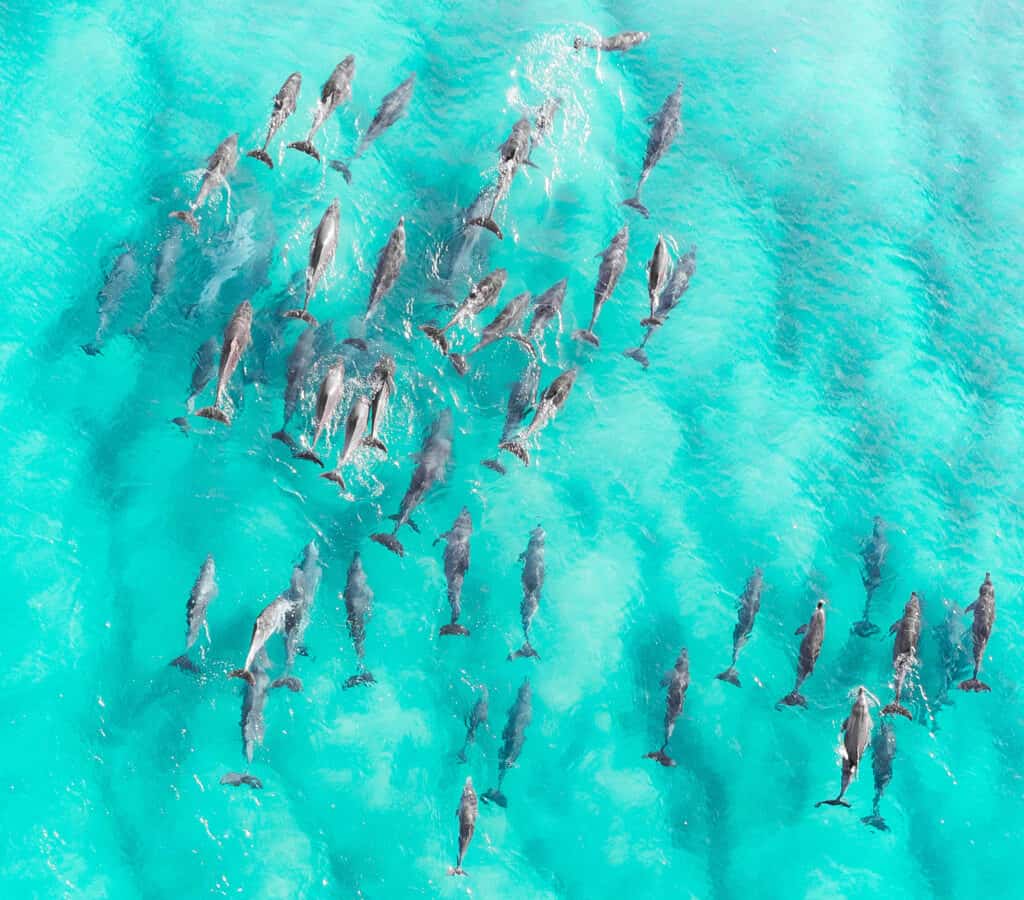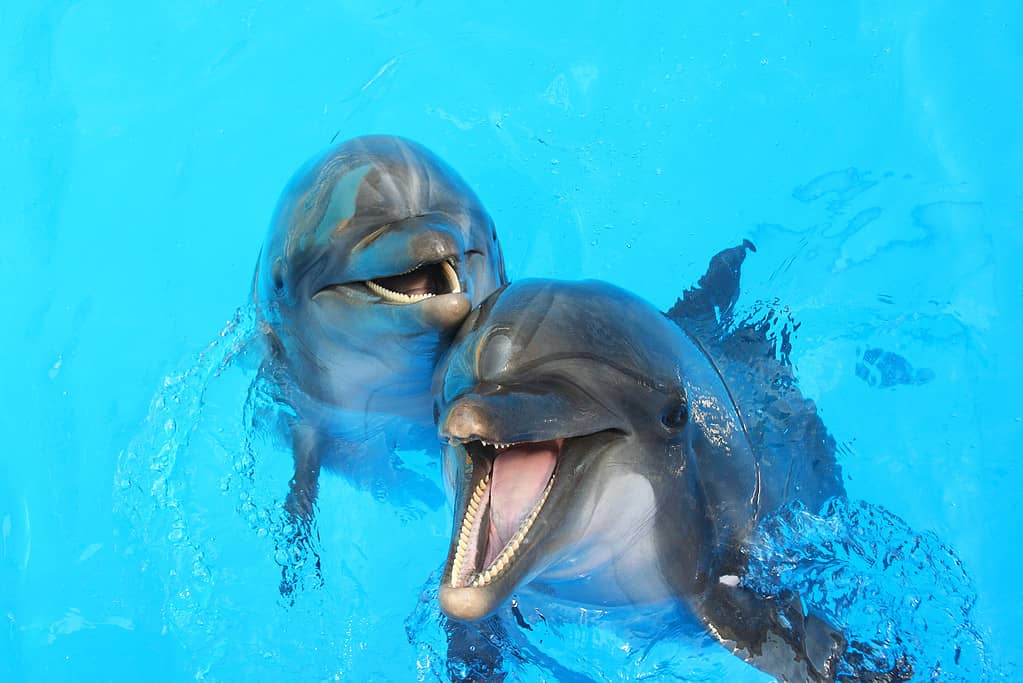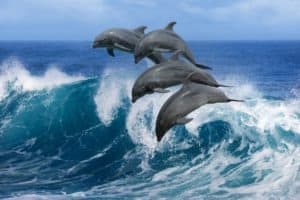Most of the 43 species of dolphins like to stick together in groups, but what are those groups called?
A group of dolphins is called a pod.
Other less common names include a school or a team, but a pod is the most widely accepted moniker for a group of dolphins.
Dolphin Pods
John Racanelli, president, and chief executive officer of the National Aquarium, reminded attendees at a TEDx event, “[Dolphins have] lived on this planet, largely as they are today, for five million years.”
This means dolphin pods have also likely been around for five million years. That’s right, kids. Before there were iPods or AirPods, there were dolphin pods.
Dolphins aren’t the only cetaceans living in pod groups, though. A group of porpoises and a group of whales are both commonly known as pods, too.
Dolphin pods often number from ten to thirty individuals, although the number can vary both higher and lower.

Dolphin pods are critical to the life and well-being of each individual member.
©F Photography R/Shutterstock.com
Types of Dolphin Pods
There are four types of dolphin pods.
Nursery Pods
These pods are made up of mothers and their young. Calves remain with their mothers for several years after birth, sometimes as long as eight years. These groups are also multi-generational. When a mature female dolphin is pregnant, she often returns to her original nursery pod to give birth and then protect her calf.

Nursery pods mainly consist of mothers and their calves.
©iStock.com/NaluPhoto
Juvenile Pods
When dolphins leave their nursery pod, they often join together with other dolphins around the same age. Both male and female dolphins are members of these juvenile dolphin pods. It can take a while to “cut the apron strings,” though. Juveniles can toggle back and forth between the juvenile pod and their original nursery pod. They are almost always accepted in both groups, so they can move between the two as they wish.
Adult Males
These pods are often, though not always, comprised of siblings. These males join together in a group lasting up to twenty years.
Megapods
Sometimes multiple pods join together, creating a megapod (also known as a superpod). Megapods are typically formed when food is abundant in a certain area. These megapods can also form for mating purposes.
The dolphins in these megapods can number in the hundreds, sometimes even over a thousand. Some megapods can stretch up to a mile long. But the megapods don’t stay together very long. When the feeding or mating ends, the megapod breaks up, and the dolphins revert back to their original pods.

Dolphin megapods can stretch up to a mile long.
©iStock.com/lennjo
Why Do Dolphins Live in Pods?
As with most phenomena in the natural world, there are reasons why dolphins group together in pods.
Hunting
Dolphins are carnivores that hunt a variety of aquatic animals. Most of their diet is comprised of fish, but they will also predate squid, jellyfish, and crustaceans. Dolphins may even feed on small birds or aquatic mammals on rare occasions.
Dolphins often hunt as a team. It makes the hunt easier and more effective.
For example, this video shows how a pod of dolphins herded a school of fish together into a bait ball.
A solitary dolphin could never do this, but this pod of dolphins worked together to bring this school of fish together into a tight ball. Once the bait ball was formed, the dolphins could feed quickly and easily. As some of the dolphins ate, others made sure the bait ball didn’t disperse. Then the dolphins would swap roles.
In shallow water, dolphins sometimes use a technique called “strand feeding, “ as seen in the video below.
These bottlenose dolphins in South Carolina formed a pressure wave that chased a school of mullet toward the beach. When they were pinned against the shore, the fish turned and leaped back toward the water, right into the dolphins’ jaws.
Again, a single dolphin would stand little chance of catching any fish in this scenario. This sophisticated hunting technique requires an impressive level of understanding and cooperation among all the dolphins in the pod.
Protection
As with many predators in nature, the predator can sometimes become the prey. Dolphins are on the menu for sharks and orcas. These apex ocean predators especially look for juveniles or sick/injured dolphins. The dolphin pod is essential to protect these vulnerable individuals.
This video shows a pod of dolphins protecting a juvenile from multiple sharks.
Dolphins do not have large jaws or razor-sharp teeth with which to defend themselves. Their best defense is found in their numbers.
When defending against a shark attack, the adult dolphins in the pod will ram the shark with their beaks. They take aim at the sensitive parts of the shark’s body, like the belly and, most especially, the gills. That may not sound like much against a large, fearsome predator, but it’s all about the numbers. One dolphin ramming a shark may have little effect, but a pod of dozens all ramming the predator together is enough to turn away even a large great white shark. It is only possible through both courage and coordination among the dolphins of the pod.
It doesn’t always work, of course. Young dolphins have a high mortality rate. But, while the pod can’t always fend off a shark attack, it does give its vulnerable members their best chance at survival.
Social Needs
Dolphins are highly intelligent creatures. Their brains are actually larger than human brains, though the dolphin’s prefrontal cortex and hippocampus are rather small and underdeveloped. Still, many scientists believe dolphins to be the second most intelligent creature on Earth.
As discussed in the hunting and protection scenarios above, dolphins are capable of remarkable levels of cooperation. This stems in large part from their sophisticated communication.
As the above video demonstrates, dolphins communicate through hundreds of different clicks, whistles, and other sounds. Similar to how every person’s voice is unique, each dolphin develops a unique whistle recognizable to other pod members. The area of the dolphin’s brain used to process sound is roughly times larger than that of a human. This, again, sheds light on just how intelligent these mammals really are.
This communication is used in hunting and to defend against attack, but it is also used socially. Dolphins live in a highly-social community. Very few animal groups rival the social connection that exists within a dolphin pod. Apes, elephants, and toothed whales are among the very small number of animals with such social structures.
Dolphin Emotions
Dolphins live in pods, not just for hunting and protection but also for socialization. Dolphins display a range of emotions, including elation and grief. Research even indicates that dolphins are capable of acting empathetically and altruistically.
Dolphins are self-aware, able to recognize themselves in a mirror. They also have special cells in their brains known as spindle neurons. These cells were once thought to only exist in humans and a select few other highly-developed primate brains. Spindle neurons are particularly connected with empathy. This means that dolphins are both self-aware and others-aware, making the social network of a pod that much more important to each individual dolphin.
While we do not yet understand much about the cognition and emotions of these remarkable animals, it is clear there are mental, emotional, and social needs that can only be met within the pod.

Dolphins are capable of a variety of emotions, quite possibly including grief and empathy.
©Elena Larina/Shutterstock.com
Thank you for reading! Have some feedback for us? Contact the AZ Animals editorial team.








